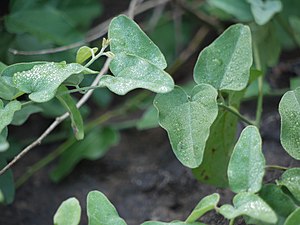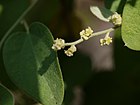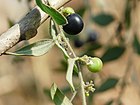Note: This is a project under development. The articles on this wiki are just being initiated and broadly incomplete. You can Help creating new pages.
Cocculus hirsutus - Patalagarudi
Patalagarudi is a slender climber with soft hairy leaves. This plant can be found in dry areas during and after the monsoon.
Uses
Parts Used
Chemical Composition
The stem contains cyclopeptide alkaloids. The plant contains coclaurine, magnoflorine, beta-sitosterol, ginnol and a monomethyl ether of inositol. [2]
Common names
| Language | Common name |
|---|---|
| Kannada | Aadama balli, Adambuballi, Daagadiballi, Kaage maari, Sugadi balli |
| Hindi | Bajar bel, Jamti-ki-bel, Patal garudi |
| Malayalam | Pathalagarudakkodi |
| Tamil | Anantavalli, Calakattu, Kattukkodi, Nirppantikkoti, Uppaittiricci |
| Telugu | Cheepurutheega, Chipurutige, Doosaratheege |
| Marathi | NA |
| Gujarathi | NA |
| Punjabi | NA |
| Kashmiri | NA |
| Sanskrit | Garudi, Chilahinta, Vatsadani, Vikranta |
| English |
Properties
Reference: Dravya - Substance, Rasa - Taste, Guna - Qualities, Veerya - Potency, Vipaka - Post-digesion effect, Karma - Pharmacological activity, Prabhava - Therepeutics.
Dravya
Rasa
Tikta (Bitter)
Guna
Laghu (Light), Picchila (Sticky)
Veerya
Ushna (Hot)
Vipaka
Katu (Pungent)
Karma
Vata, Pitta,Kapha
Prabhava
Vishagna (Anti-poison)
Habit
Identification
Leaf
| Kind | Shape | Feature |
|---|---|---|
| Simple | Alternate | 1.5-7 x 0.5-4.7 cm, variable in shape, the lower leaves of the main branches larger, sometimes 3-5 lobed. |
Flower
| Type | Size | Color and composition | Stamen | More information |
|---|---|---|---|---|
| Unisexual | Axillary | Greenish yellow | Male flowers: sepals greenish, pilose, 3 inner broadly ovate to obovate, 1.5-2.5 mm long. |
Fruit
| Type | Size | Mass | Appearance | Seeds | More information |
|---|---|---|---|---|---|
| A drupe | 4 - 8mm | Turning black, 4-8 mm diam.; endocarp ridged with a prominent do | {{{5}}} | {{{6}}} |
Other features
List of Ayurvedic medicine in which the herb is used
Where to get the saplings
Mode of Propagation
How to plant/cultivate
Season to grow
Soil type
Propagation
Commonly seen growing in areas
Photo Gallery
References
External Links
Categories:
- Ayurvedic Herbs known to be helpful to treat Aphrodisiac
- Ayurvedic Herbs known to be helpful to treat Burning sensation
- Ayurvedic Herbs known to be helpful to treat Gastritis
- Ayurvedic Herbs known to be helpful to treat Skin diseases
- Ayurvedic Herbs known to be helpful to treat Poisoning
- Herbs with Bark used in medicine
- Herbs with Leaves used in medicine
- Herbs with Heartwood used in medicine
- Herbs with Seeds used in medicine
- Herbs with common name in Kannada
- Herbs with common name in Hindi
- Herbs with common name in Malayalam
- Herbs with common name in Tamil
- Herbs with common name in Telugu
- Herbs with common name in Sanskrit
- Habit - Climber
- Index of Plants which can be propagated by Seeds
- Index of Plants which can be propagated by Cuttings
- Herbs that are commonly seen in the region of Tropical area
- Herbs
- Climber
- Ayurvedic herbs that don't have seed photos
- Menispermaceae




